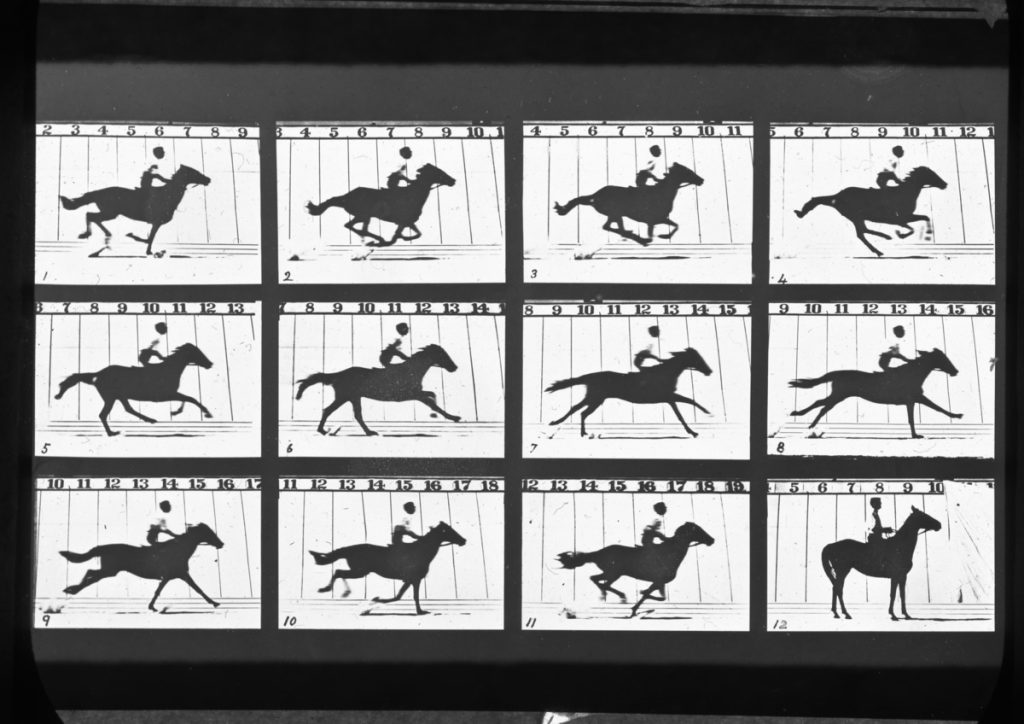The evolution of photography: ‘Sallie Gardner’ Galloping, the Horse in Motion
August 12, 2024

Eadweard Muybridge, ‘Sallie Gardner’ galloping, The Horse in Motion, 1878. © Kingston Heritage Service. Photography: Kingston Heritage Service
Note that app links work best on your smartphone with the Bloomberg Connects app downloaded.
Whether you’re familiar with The Horse in Motion or this is the first you’re hearing about it, we’ve got ten facts to share about this famous work of art, the artist, and its significance in history, including how it was a huge step in the advancement of motion pictures. Saddle up.
- Let’s start with what it is – The Horse in Motion is a series of sequential photographic images depicting the movement of a horse captured by English photographer Eadweard Muybridge.
- The artist was born Edward James Muggeridge in Kingston Upon Thames, Surrey, England, on May 8, 1830, and immigrated to the United States as a young man. (Bonus points: If you spotted the name change, he decided to adopt the original Anglo-Saxon form of his given name along the way.)
- If you want to see the images in person, it’s currently owned by and on display at Kingston Museum – a museum that celebrates the Royal Borough of Kingston upon Thames, England. It has a gallery dedicated to Eadweard Muybridge, who left his entire personal collection to the museum.
- Muybridge first drew attention in 1868 for his large historical photographs of Yosemite Valley, California. A few years later, he started experimenting with photographing movement and produced his most famous images: The Horse in Motion.
- How did it come about? Railroad magnate and horse breeder Leland Stanford was interested in horse gait analysis and hired Muybridge to photograph his celebrated horse.
- After many iterations of the process and a few interruptions, The Horse in Motion is the first example of chronophotography. This method was pioneered by Eadweard Muybridge in 1878 and used to document different phases of motion for scientific study.
- How did he do it? – Muybridge set up a long line of 24 cameras. Thin strings were stretched across the track where a horse was to run, with one end attached to the camera. When the horse passed, the strings broke, and the pictures were taken in sequence.
- Before this cabinet card photo series, there was a trend for painting horses with all legs off the floor – the flying gallop. Riders suspected it, but the movement was so fast that there was no way of knowing for sure. Muybridge was the first photographer to capture a horse mid-gallop, proving all four legs left the floor as it moved.
- Not only did it help us understand how horses move, but it also formed an important step in the development of motion pictures. Muybridge invented the zoopraxiscope in 1880 to project his chronophotographic pictures in motion, in part to prove they were genuine. It’s said to be the world’s first bit of cinema.
- Muybridge went on to work with the University of Pennsylvania to make his most important photographic studies, producing over 100,000 images of animals and humans in motion between 1884 and 1886.
Keen to hear more about the Kingston Museum exhibits and one of the most famous photographers in history? Download the app and explore the Kingston Museum guide. There’s so much more to discover with Bloomberg Connects, about this piece and thousands of others.